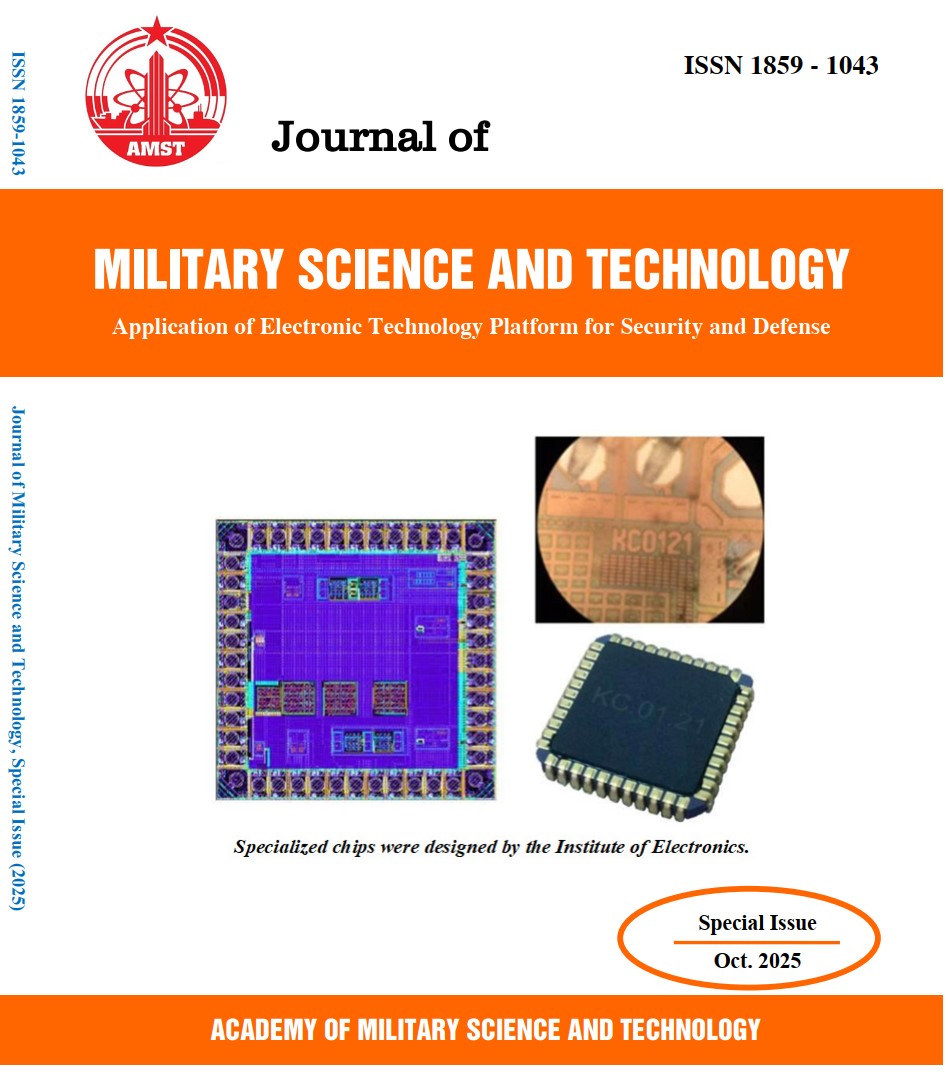Investigation of hybrid detector structures for surveillance radar with correlated target fluctuations
172 viewsDOI:
https://doi.org/10.54939/1859-1043.j.mst.IITE.2025.83-90Keywords:
Surveillance radar; Target detection; Correlated target fluctuations; Coherent integration; Noncoherent integration; Hybrid detector structures.Abstract
This paper investigates the effect of temporally correlated target fluctuations on pulse-train integration efficiency in surveillance radar. A proper complex Gaussian signal model in white noise is assumed. Two hybrid detector structures are synthesized using principal component analysis, where coherent integration is limited to selected subspaces and the remaining components are processed noncoherently. Hybrid-1 restricts coherent integration to the dominant eigen-direction, whereas Hybrid-90 extends it to the subspace capturing 90% of the signal energy. Their performance, measured in terms of detection probability and computational complexity, is evaluated against two widely used reference classes in radar detection: noncoherent energy detection and matched-filter–based coherent integration schemes. The maximum-likelihood detector serves as the optimal benchmark. Monte Carlo simulations across different target fluctuation characteristics and signal-to-noise ratios show that the proposed hybrids achieve a more stable detection probability than conventional schemes while approaching the optimal bound. Hybrid-1, in particular, offers a favorable trade-off between detection reliability and algorithmic complexity. The results provide practical guidelines for surveillance radar design and suggest directions for further research.
References
[1]. Skolnik, M. “Radar handbook,” 3rd ed., New York: McGraw-Hill, (2008).
[2]. Richards, M. A., Scheer, J. A., and Holm, W. A. “Principles of modern radar: Basic principles,” Raleigh, NC, USA: SciTech Publishing, Inc., (2010). DOI: https://doi.org/10.1049/SBRA021E
[3]. De Maio, A., and Greco, M. “Modern radar detection theory,” Pisa: University of Pisa, (2016). DOI: https://doi.org/10.1049/SBRA509E
[4]. Weinberg, G. “Radar detection theory of sliding window processes,” CRC Press, (2017). DOI: https://doi.org/10.1201/9781315154015
[5]. De Maio, D., Farina, A., and Foglia, G. “Target fluctuation models and their application to radar performance prediction,” IEE proceedings – radar, sonar and navigation, 151(5), 261–269, (2004). DOI: https://doi.org/10.1049/ip-rsn:20040842
[6]. Zhang, L., Chen, H., Qu, Q., and Wang, Y. “Radar non-coherent integration detection for high-speed multiple targets via Doppler frequency compression,” IEEE transactions on aerospace and electronic systems, 61(2), 3092–3105, (2024). DOI: https://doi.org/10.1109/TAES.2024.3481348
[7]. He, Z., Chen, X., Zhang, H., and Zhang, L. “Long-time integration for drone targets detection based on digital ubiquitous radar,” in IEEE 5th international conference on electronic information and communication technology (ICEICT), Hefei, China, 21–23 August 2022, (2022). DOI: https://doi.org/10.1109/ICEICT55736.2022.9909060
[8]. Zhao, L., Tao, H., Chen, W., and Song, D. “Maneuvering target detection based on subaperture joint coherent integration,” remote sensing, 13(10), 1948, (2021). DOI: https://doi.org/10.3390/rs13101948
[9]. Liu, G., Tian, Y., Wen, B., and Liu, C. “Combined coherent and non-coherent long-time integration method for high-speed target detection using high-frequency radar,” remote sensing, 16(12), 2139, (2024). DOI: https://doi.org/10.3390/rs16122139
[10]. Xu, J., Zhou, X., Qian, L., Xia, X., and Long, T. “Hybrid integration for highly maneuvering radar target detection based on generalized radon-fourier transform,” IEEE transactions on aerospace and electronic systems, 52(5), 2554–2561, (2016). DOI: https://doi.org/10.1109/TAES.2016.150076
[11]. Zhou, X., Qian, L., Ding, Z., Xu, J., Liu, W., and You, P. “Radar detection of moderately fluctuating target based on optimal hybrid integration detector,” IEEE transactions on aerospace and electronic systems, 55(5), 2408–2425, (2019). DOI: https://doi.org/10.1109/TAES.2018.2887198
[12]. Zhang, Z., Liu, N., Hou, Y., Zhang, S., and Zhang, L. “A coherent integration segment searching based GRT–GRFT hybrid integration method for arbitrary fluctuating target,” remote sensing, 14(11), 2695, (2022). DOI: https://doi.org/10.3390/rs14112695
[13]. Zheng, H., Zhang, Q., Zhang, Y., and Yan, S. “Hybrid integration detection of moving target with moderately fluctuating RCS,” IET international radar conference (IRC 2023), 47, 4060–4064, (2024). DOI: https://doi.org/10.1049/icp.2024.1763
[14]. Jolliffe, I. T. “Principal component analysis,” New York: Springer, (2002).
[15]. Abdi, H., and Williams, L. J. “Principal component analysis,” wiley interdisciplinary reviews: computational statistics, 2(4), 433–459, (2010). DOI: https://doi.org/10.1002/wics.101







